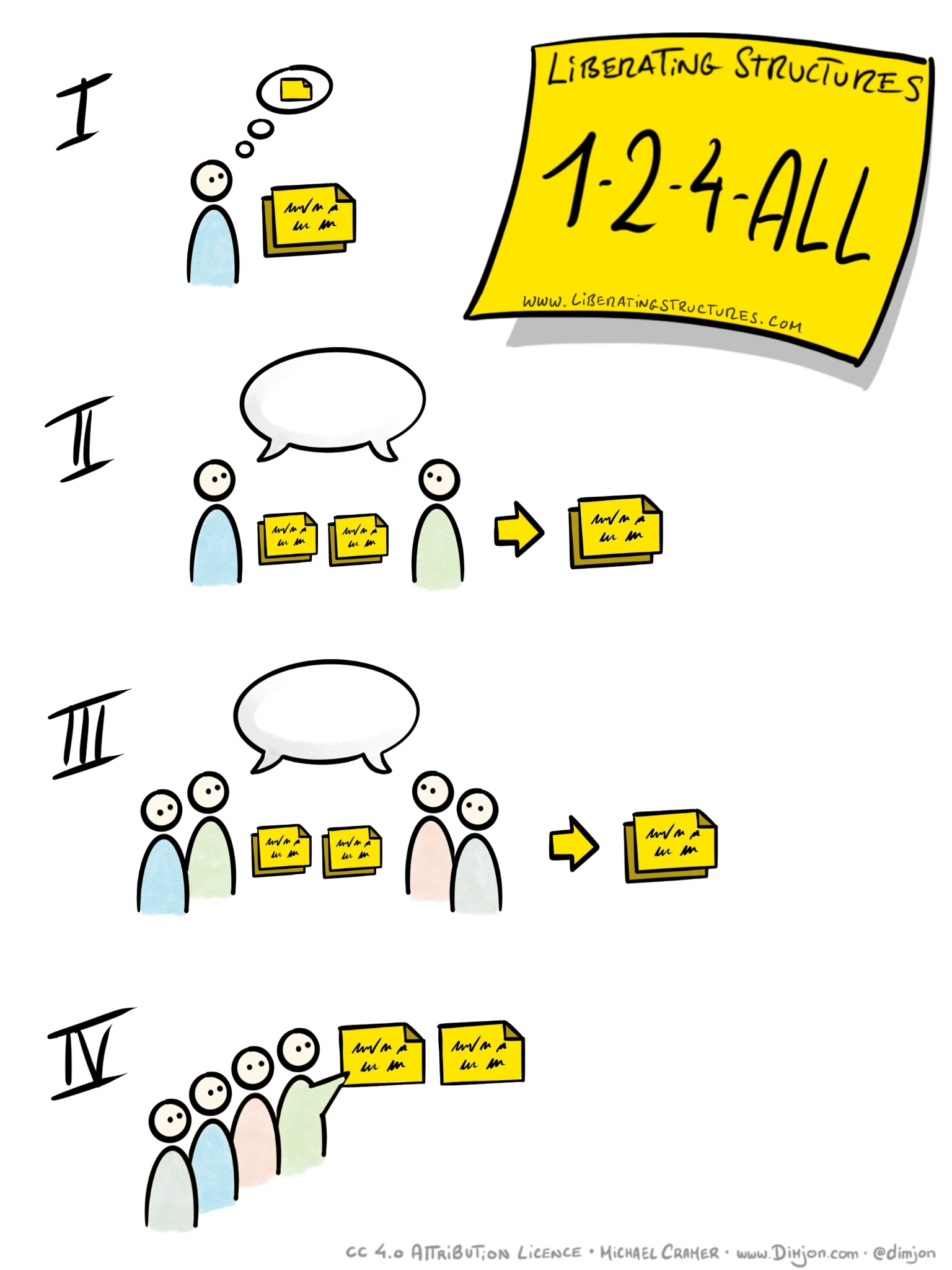I love talking about facilitation!
The skill of facilitation is my passion and the cornerstone of my ikigai.
Whenever I talk about facilitation with groups, the one issue that keeps cropping up time and again, like a phoenix reborn of its ashes, is that of distributing talking time more equitably.
I hear variations of:
How do I get people to share their thoughts?
How to make shy people contribute?
What can I do for introverts to speak up?
How can I ensure that we don’t just hear xyz (the most confident speaker[s] in the room)?
(said various people, in various forms, in various conversations)
The questions above actually allude to at least 3 different things:
- How to ensure the people that speak easily are not the only ones heard?
- How to make sure people share what’s on their mind generally?
- How to make sure that the people who tend to speak less are also heard and contributing.
It’s the latter challenge that I’m specifically focusing on here.
Side note: There are various reasons why people don’t speak up in meetings as you can watch in this video or that one. But why they don’t speak up is not my focus here. Perhaps for another blog post…

Here, I want to explore how we can make space for the not-so-usual suspects, as I am invited to share my facilitative experience on this issue time and again.
Therefore, last time this came up in a conversation, I decided to follow my meta reflex: instead of sharing it just for that conversation, I took the opportunity to nail this issue for the future and have a handy list of tips and tricks at the ready:
Here are my most common go-to approaches to ensure that the people who tend to speak less are also sharing their best thinking with the rest of the group:

Start with individual reflection
This really started much more intentionally with my Liberating Structures practice and I’ve found this to be soooo valuable: invite participants to take some time (it can be as short as 30 seconds, it can be one minute, two minutes, 5, heck, half an hour if you want) to collect their thoughts, at peace.
It helps introverts and slower thinkers to collect their thoughts and crystallise them. It gives introverts in particular some well appreciated quiet time. It invites extroverts to actually slow down and also reflect rather than talk straight off the bat.
When everyone shares their thoughts, in principle they have something slightly more distilled to contribute.
Use small breakouts to hear our own voice and take steps to feel more confident in higher risk arenas (like a plenary group)
A next obvious tactic is to let people build their own confidence or willingness to speak in smaller groups. It’s much easier to feel invited to talk when you’re just with 2-3 other people, let alone just one other person. In the process we both hear our voice which helps us remember we have a voice in larger groups.
We also tend to build more of a rapport with each other in smaller groups. This way, together we build psychological safety (the premise towards brave sharing) and thus feel more inclined to speak up and reveal more of our ‘private conversation’ with the rest of the group.

1-2-4-all as the mix and match of the previous two
It’s only natural to feature 1-2-4-all as a great way to liberate everyone’s voice because it builds on the opportunities from the previous two tactics, and does this in small, incremental steps.
If used repeatedly, 1-2-4-all makes it even easier to share more…
Use a talking object

Another simple yet powerful tactic is to impose the use of a ‘talking object’ (be it a microphone, a stick, a marker, a book, a Playmobil figure, whatever) whenever we want to talk. This is great as it invites us to both listen to all the voices very intently (when we don’t hold the object, we are invited to remain silent and listen to understand) and to speak without the fear that we will be interrupted by the confident, powerful, typical voices. Whether used in a specific participation format (e.g. a Conversation Café) or in an open discussion, a talking object can go a long way to create space for people who are likely not to talk much or even at all.
Structured go-arounds
This tactic is slightly more invasive – putting, one by one, everyone on the spot – but because it applies to everyone, it’s a more equitable and acceptable practice for everyone to speak up. And in a good structured go-around you can always pass your turn and come back in the next round (when you get to hear all the turns that were passed).
It typically starts with anyone who feels ready and then moves clockwise or anti-clockwise from there. Easier to use in a circle set up, but can be used in any setting. And dead easy to use online too.
Pass the baton / choosing the next speaker
A slight variation to the structured go-around is to have the first person to speak to do their bit and once they’re done, to let them choose who speaks. Eventually, everyone gets to speak this way too.
Great, here too, to give the option to pass. Sometimes your turn comes and you’re not ready and it feels rather awkward to feel like we have to say something smart when we don’t feel ready. So that buys you more time to gather your thoughts.
And this can be with a ball (or even a ball of wool that entangles everyone, which can add a fun community building factor).
Switch to writing instead of talking

Public speaking is apparently the number one fear for many people (75% of people are affected by this glossophobia if one is to believe the article). So how about asking people to write instead of talking?
Whether on a post-it note or index card, or on a digital whiteboard, this tactic invites everyone to share their thoughts without the perceived risk of being ridiculed while talking in public (which even though a not founded fear, is at the heart of glossophobia).
Or even something else…
And if writing is still too rational, you may also resort to inviting people to draw, to use their body (miming, theatre, dancing) to share their views. This can be an incredibly refreshing break in the gathering. It definitely opens up new – and perhaps more suitable – avenues for people to share their insights and ideas.
Use a set of matchsticks
I was reminded recently of this technique which, frankly, I’ve never used, but it could prove very handy: Provide x matchsticks to everyone in the room (3? 5?). Every time they make an allocution, they give away one of their matchsticks. Once they have exhausted all their sticks, they just have to listen to everyone else.
This is great because it reminds the eager speakers of the risk of ‘burning’ their matchsticks too quickly. For the frugal speakers, it visually shows them the opportunity, and power, in their hands to speak up.

Mak space for the quiet person / balance
Sometimes an active listening skill does the trick very nicely. You use ‘making space for the quiet person’ (read more about it in the Facilitator’s Guide to Participatory Decision-Making), in a plenary session, calling for voices that haven’t been heard for a while, without naming anyone in particular. The invitation is on the table for those that have not spoken much. And it’s a hidden reminder for the eager speakers that they may want to consider how much space they’re leaving for others. It doesn’t always work, but in combination with other tactics here, this can really help.
Similarly ‘balancing’ is inviting voices from a specific demographic. E.g. “Could we hear more female voices now?” or “What do the students think of this?” or “It would be great to hear the perspective of the community representatives on this topic”… These are gentle methods to invite less loud voices.
Use participation formats that deliberately create less pressure to speak up
Sometimes it’s the pressure to talk (often equated with a pressure to ‘perform’ and say something smart) that blocks people. Using participation formats that create a low pressure environment can be transformational.
Here, I’m thinking particularly of ‘unhurried conversations‘. In an unhurried conversation, anyone can speak, without interruption (it’s akin to using a talking object, and sometimes an unhurried conversation uses one such object) for however long you want, without actually having to speak up, to react, to answer, to pick up on anyone else’s thread. You can simply say whatever you want without being interrupted or judged. Sometimes that’s just what you need to speak up.
And as its champion Johnnie Moore says, it adds an incredible focus on listening for everyone else.

Use participation formats that specifically make space for the quiet voices
Sometimes a participation format goes beyond the low pressure to speak and actually inverts it to create a platform for ONLY some people to speak: all fishbowls, a celebrity interview etc. can be a great opportunity to feature voices of people that are typically eclipsed by others in a gathering. If everyone else’s silent listening is ensured, it can be a powerful moment to hear precious thoughts and voices in the choir.
Offer a final opportunity for people to take their responsibilities to speak up before moving on
Not my preferred move, but sometimes it can also be useful to move on from a conversation by giving one last opportunity to anyone, especially the quiet person or unheard demographics, to make a final intervention before everyone accepts that the conversation is closed (at least for now). The sense of urgency can cause some people to suddenly speak up…
🤔 What other methods, tactics, tips and tricks do you have to balance the speaking time?
On this note, I leave you with a video specifically crafted for formal leaders. It looks at the other side of this reflection: when might you be talking too much (which is not only a valid question for formal leaders by the way)?

Leave a comment